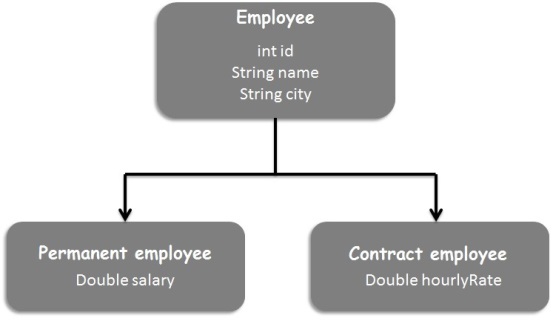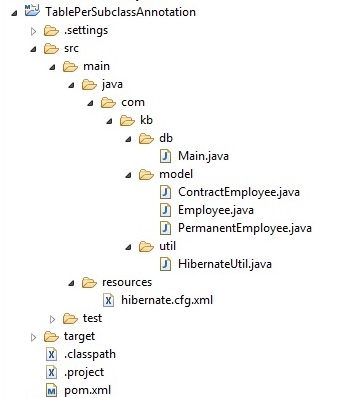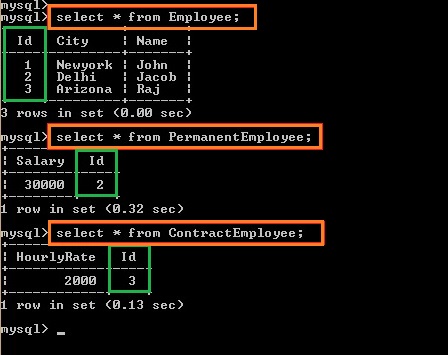Table per subclass with annotation
In previous article we saw Table per Subclass using XML
In this article, we will learn the same using Annotation.
Let us understand about Table Per Subclass with Annotation
In this strategy, each subclass table will have the subclass specific attributes only.
Parent class attributes will be stored in Parent class table.
Subclass tables will have foreign key associations to the superclass table
So there will not be any duplicate columns in the subclass table except one column which is anyway required to maintain the relation between Parent and subclass tables through foreign key.
In this strategy, number of tables is equal to number of classes.
Let’s consider the below example

In this example, we have 3 classes where Employee class is the super class for both PermanentEmployee and ContractEmployee classes.
We will have 3 tables created one for each class.
Let’s create hibernate project using this strategy
Step 1
Create hibernate project
Please refer Hibernate setup in eclipse article on how to do it.
Project structure

Step 2
Update pom.xml with Hibernate and Mysql dependencies
- <project xmlns="http://maven.apache.org/POM/4.0.0" xmlns:xsi="http://www.w3.org/2001/XMLSchema-instance"
- xsi:schemaLocation="http://maven.apache.org/POM/4.0.0 http://maven.apache.org/xsd/maven-4.0.0.xsd">
- <modelVersion>4.0.0</modelVersion>
- <groupId>TablePerSubclassAnnotation</groupId>
- <artifactId>TablePerSubclassAnnotation</artifactId>
- <version>0.0.1-SNAPSHOT</version>
- <packaging>jar</packaging>
- <name>TablePerSubclassAnnotation</name>
- <url>http://maven.apache.org</url>
- <properties>
- <project.build.sourceEncoding>UTF-8</project.build.sourceEncoding>
- </properties>
- <dependencies>
- <dependency>
- <groupId>junit</groupId>
- <artifactId>junit</artifactId>
- <version>3.8.1</version>
- <scope>test</scope>
- </dependency>
- <!-- https://mvnrepository.com/artifact/org.hibernate/hibernate-core -->
- <dependency>
- <groupId>org.hibernate</groupId>
- <artifactId>hibernate-core</artifactId>
- <version>5.2.6.Final</version>
- </dependency>
- <!-- https://mvnrepository.com/artifact/mysql/mysql-connector-java -->
- <dependency>
- <groupId>mysql</groupId>
- <artifactId>mysql-connector-java</artifactId>
- <version>6.0.5</version>
- </dependency>
- </dependencies>
- </project>
<project xmlns="http://maven.apache.org/POM/4.0.0" xmlns:xsi="http://www.w3.org/2001/XMLSchema-instance"
xsi:schemaLocation="http://maven.apache.org/POM/4.0.0 http://maven.apache.org/xsd/maven-4.0.0.xsd">
<modelVersion>4.0.0</modelVersion>
<groupId>TablePerSubclassAnnotation</groupId>
<artifactId>TablePerSubclassAnnotation</artifactId>
<version>0.0.1-SNAPSHOT</version>
<packaging>jar</packaging>
<name>TablePerSubclassAnnotation</name>
<url>http://maven.apache.org</url>
<properties>
<project.build.sourceEncoding>UTF-8</project.build.sourceEncoding>
</properties>
<dependencies>
<dependency>
<groupId>junit</groupId>
<artifactId>junit</artifactId>
<version>3.8.1</version>
<scope>test</scope>
</dependency>
<!-- https://mvnrepository.com/artifact/org.hibernate/hibernate-core -->
<dependency>
<groupId>org.hibernate</groupId>
<artifactId>hibernate-core</artifactId>
<version>5.2.6.Final</version>
</dependency>
<!-- https://mvnrepository.com/artifact/mysql/mysql-connector-java -->
<dependency>
<groupId>mysql</groupId>
<artifactId>mysql-connector-java</artifactId>
<version>6.0.5</version>
</dependency>
</dependencies>
</project>
Step 3
Create Employee class
- package com.kb.model;
- import javax.persistence.Column;
- import javax.persistence.Entity;
- import javax.persistence.GeneratedValue;
- import javax.persistence.Id;
- import javax.persistence.Inheritance;
- import javax.persistence.InheritanceType;
- import javax.persistence.Table;
- @Entity
- @Table(name = "Employee")
- @Inheritance(strategy=InheritanceType.JOINED)
- public class Employee {
- @Id
- @GeneratedValue
- @Column(name = "Id")
- private int id;
- @Column(name = "Name")
- private String name;
- @Column(name = "City")
- private String city;
- public int getId() {
- return id;
- }
- public void setId(int id) {
- this.id = id;
- }
- public String getName() {
- return name;
- }
- public void setName(String name) {
- this.name = name;
- }
- public String getCity() {
- return city;
- }
- public void setCity(String city) {
- this.city = city;
- }
- }
package com.kb.model;
import javax.persistence.Column;
import javax.persistence.Entity;
import javax.persistence.GeneratedValue;
import javax.persistence.Id;
import javax.persistence.Inheritance;
import javax.persistence.InheritanceType;
import javax.persistence.Table;
@Entity
@Table(name = "Employee")
@Inheritance(strategy=InheritanceType.JOINED)
public class Employee {
@Id
@GeneratedValue
@Column(name = "Id")
private int id;
@Column(name = "Name")
private String name;
@Column(name = "City")
private String city;
public int getId() {
return id;
}
public void setId(int id) {
this.id = id;
}
public String getName() {
return name;
}
public void setName(String name) {
this.name = name;
}
public String getCity() {
return city;
}
public void setCity(String city) {
this.city = city;
}
}
@Entity annotation is used to indicate the class as persistent entity.
@Table annotation indicates the table name where this entity has to be persisted
@Inheritance annotation is used for implementing inheritance in hibernate.
It helps us to define the inheritance strategy.
We have used JOINED as inheritance strategy for Table per subclass.
@Inheritance annotation is defined at root class level or sub hierarchy class level where different strategy has to be applied.
@Id is used to specify the primary key column.
@GeneratedValue is used to specify the primary key generation strategy.
@Column is used to specify the details of the column to which a field or property will be mapped
Step 4
Create PermanentEmployee class
- package com.kb.model;
- import javax.persistence.Column;
- import javax.persistence.Entity;
- import javax.persistence.PrimaryKeyJoinColumn;
- import javax.persistence.Table;
- @Entity
- @Table(name="PermanentEmployee")
- @PrimaryKeyJoinColumn(name="Id")
- public class PermanentEmployee extends Employee{
- @Column(name = "Salary")
- private double salary;
- public double getSalary() {
- return salary;
- }
- public void setSalary(double salary) {
- this.salary = salary;
- }
- }
package com.kb.model;
import javax.persistence.Column;
import javax.persistence.Entity;
import javax.persistence.PrimaryKeyJoinColumn;
import javax.persistence.Table;
@Entity
@Table(name="PermanentEmployee")
@PrimaryKeyJoinColumn(name="Id")
public class PermanentEmployee extends Employee{
@Column(name = "Salary")
private double salary;
public double getSalary() {
return salary;
}
public void setSalary(double salary) {
this.salary = salary;
}
}
Step 5
Create ContractEmployee class
- package com.kb.model;
- import javax.persistence.Column;
- import javax.persistence.Entity;
- import javax.persistence.PrimaryKeyJoinColumn;
- import javax.persistence.Table;
- @Entity
- @Table(name="ContractEmployee")
- @PrimaryKeyJoinColumn(name="Id")
- public class ContractEmployee extends Employee {
- @Column(name ="HourlyRate")
- private double hourlyRate;
- public double getHourlyRate() {
- return hourlyRate;
- }
- public void setHourlyRate(double hourlyRate) {
- this.hourlyRate = hourlyRate;
- }
- }
package com.kb.model;
import javax.persistence.Column;
import javax.persistence.Entity;
import javax.persistence.PrimaryKeyJoinColumn;
import javax.persistence.Table;
@Entity
@Table(name="ContractEmployee")
@PrimaryKeyJoinColumn(name="Id")
public class ContractEmployee extends Employee {
@Column(name ="HourlyRate")
private double hourlyRate;
public double getHourlyRate() {
return hourlyRate;
}
public void setHourlyRate(double hourlyRate) {
this.hourlyRate = hourlyRate;
}
}
Step 6
Create hibernate.cfg.xml
- <?xml version="1.0" encoding="UTF-8"?>
- <!DOCTYPE hibernate-configuration PUBLIC
- "-//Hibernate/Hibernate Configuration DTD 3.0//EN"
- "http://www.hibernate.org/dtd/hibernate-configuration-3.0.dtd">
- <hibernate-configuration>
- <session-factory>
- <!-- Database connection properties -->
- <property name="connection.driver_class">com.mysql.jdbc.Driver</property>
- <property name="connection.url">jdbc:mysql://localhost/javainsimpleway</property>
- <property name="connection.username">root</property>
- <property name="connection.password">root</property>
- <!-- JDBC connection pool (using the built-in) -->
- <property name="connection.pool_size">1</property>
- <!-- SQL dialect -->
- <property name="dialect">org.hibernate.dialect.MySQLDialect</property>
- <!-- Disable the second-level cache -->
- <property name="cache.provider_class">org.hibernate.cache.internal.NoCacheProvider</property>
- <!-- Echo all executed SQL to stdout -->
- <property name="show_sql">true</property>
- <!-- Format the generated Sql -->
- <property name="format_sql">true</property>
- <!-- Dont Drop and re-create the database schema on startup,Just update it -->
- <property name="hbm2ddl.auto">update</property>
- <mapping class="com.kb.model.Employee" />
- <mapping class="com.kb.model.ContractEmployee" />
- <mapping class="com.kb.model.PermanentEmployee" />
- </session-factory>
- </hibernate-configuration>
<?xml version="1.0" encoding="UTF-8"?>
<!DOCTYPE hibernate-configuration PUBLIC
"-//Hibernate/Hibernate Configuration DTD 3.0//EN"
"http://www.hibernate.org/dtd/hibernate-configuration-3.0.dtd">
<hibernate-configuration>
<session-factory>
<!-- Database connection properties -->
<property name="connection.driver_class">com.mysql.jdbc.Driver</property>
<property name="connection.url">jdbc:mysql://localhost/javainsimpleway</property>
<property name="connection.username">root</property>
<property name="connection.password">root</property>
<!-- JDBC connection pool (using the built-in) -->
<property name="connection.pool_size">1</property>
<!-- SQL dialect -->
<property name="dialect">org.hibernate.dialect.MySQLDialect</property>
<!-- Disable the second-level cache -->
<property name="cache.provider_class">org.hibernate.cache.internal.NoCacheProvider</property>
<!-- Echo all executed SQL to stdout -->
<property name="show_sql">true</property>
<!-- Format the generated Sql -->
<property name="format_sql">true</property>
<!-- Dont Drop and re-create the database schema on startup,Just update it -->
<property name="hbm2ddl.auto">update</property>
<mapping class="com.kb.model.Employee" />
<mapping class="com.kb.model.ContractEmployee" />
<mapping class="com.kb.model.PermanentEmployee" />
</session-factory>
</hibernate-configuration>
We have defined all the database configuration in this file
hbm2ddl.auto property is defined in the config file which helps in automatic creation of tables in the database based on the mapping.
If hbm2ddl.auto is “update” then it avoids the dropping and recreation of schema and tables
We have also provided the mapping class names using “mapping” tag.
Step 7
Create Hibernate util class
- package com.kb.util;
- import org.hibernate.SessionFactory;
- import org.hibernate.cfg.Configuration;
- public class HibernateUtil {
- private static final SessionFactory sessionFactory = buildSessionFactory();
- private static SessionFactory buildSessionFactory() {
- try {
- // Create the SessionFactory from hibernate.cfg.xml
- return new Configuration().configure().buildSessionFactory();
- } catch (Throwable ex) {
- // Make sure you log the exception to track it
- System.err.println("SessionFactory creation failed." + ex);
- throw new ExceptionInInitializerError(ex);
- }
- }
- public static SessionFactory getSessionFactory() {
- return sessionFactory;
- }
- public static void shutdown() {
- // Optional but can be used to Close caches and connection pools
- getSessionFactory().close();
- }
- }
package com.kb.util;
import org.hibernate.SessionFactory;
import org.hibernate.cfg.Configuration;
public class HibernateUtil {
private static final SessionFactory sessionFactory = buildSessionFactory();
private static SessionFactory buildSessionFactory() {
try {
// Create the SessionFactory from hibernate.cfg.xml
return new Configuration().configure().buildSessionFactory();
} catch (Throwable ex) {
// Make sure you log the exception to track it
System.err.println("SessionFactory creation failed." + ex);
throw new ExceptionInInitializerError(ex);
}
}
public static SessionFactory getSessionFactory() {
return sessionFactory;
}
public static void shutdown() {
// Optional but can be used to Close caches and connection pools
getSessionFactory().close();
}
}
Step 8
Create main class to interact with DB
- package com.kb.db;
- import org.hibernate.Session;
- import org.hibernate.SessionFactory;
- import org.hibernate.Transaction;
- import com.kb.model.ContractEmployee;
- import com.kb.model.Employee;
- import com.kb.model.PermanentEmployee;
- import com.kb.util.HibernateUtil;
- public class Main {
- public static void main(String[] args) {
- //Get session factory using Hibernate Util class
- SessionFactory sf = HibernateUtil.getSessionFactory();
- //Get session from Sesson factory
- Session session = sf.openSession();
- //Begin transaction
- Transaction t=session.beginTransaction();
- //Creating Employee base class record
- Employee employee=new Employee();
- employee.setName("John");
- //Creating Permanent Employee subclass record
- PermanentEmployee permanentEmployee=new PermanentEmployee();
- permanentEmployee.setName("Jacob");
- permanentEmployee.setSalary(30000);
- //Creating Contract Employee subclass record
- ContractEmployee contractEmployee=new ContractEmployee();
- contractEmployee.setName("Raj");
- contractEmployee.setHourlyRate(2000);
- //persist all the employee records
- session.persist(employee);
- session.persist(permanentEmployee);
- session.persist(contractEmployee);
- //Commit the transaction and close the session
- t.commit();
- session.close();
- System.out.println("successfully persisted all the Employee records");
- }
- }
package com.kb.db;
import org.hibernate.Session;
import org.hibernate.SessionFactory;
import org.hibernate.Transaction;
import com.kb.model.ContractEmployee;
import com.kb.model.Employee;
import com.kb.model.PermanentEmployee;
import com.kb.util.HibernateUtil;
public class Main {
public static void main(String[] args) {
//Get session factory using Hibernate Util class
SessionFactory sf = HibernateUtil.getSessionFactory();
//Get session from Sesson factory
Session session = sf.openSession();
//Begin transaction
Transaction t=session.beginTransaction();
//Creating Employee base class record
Employee employee=new Employee();
employee.setName("John");
//Creating Permanent Employee subclass record
PermanentEmployee permanentEmployee=new PermanentEmployee();
permanentEmployee.setName("Jacob");
permanentEmployee.setSalary(30000);
//Creating Contract Employee subclass record
ContractEmployee contractEmployee=new ContractEmployee();
contractEmployee.setName("Raj");
contractEmployee.setHourlyRate(2000);
//persist all the employee records
session.persist(employee);
session.persist(permanentEmployee);
session.persist(contractEmployee);
//Commit the transaction and close the session
t.commit();
session.close();
System.out.println("successfully persisted all the Employee records");
}
}
Step 10
Run the above class to check the output
Hibernate:
create table Employee (
Id integer not null auto_increment,
Name varchar(255),
City varchar(255),
primary key (Id)
)
create table ContractEmployee (
Id integer not null,
HourlyRate double precision,
primary key (Id)
)
create table PermanentEmployee (
Id integer not null,
Salary double precision,
primary key (Id)
)
alter table ContractEmployee
add constraint FKjtjm93uys6lvom6tbfgl7l9e8
foreign key (Id)
references Employee (Id)
Hibernate:
alter table PermanentEmployee
add constraint FKg52k74r5b4s4asd3t152d7jg2
foreign key (Id)
references Employee (Id)
Hibernate:
insert
into
Employee
(Name, City)
values
(?, ?)
Hibernate:
insert
into
Employee
(Name, City)
values
(?, ?)
Hibernate:
insert
into
PermanentEmployee
(Salary, Id)
values
(?, ?)
Hibernate:
insert
into
Employee
(Name, City)
values
(?, ?)
Hibernate:
insert
into
ContractEmployee
(HourlyRate, Id)
values
(?, ?)
successfully persisted all the Employee records
We can see that 3 Create statements are executed to create 3 tables.
We can see 2 alter statements are executed to create a relation between parent class table and subclass tables.
3 insert statements one for each object we persisted and other 2 insert statements are executed to insert parent table for every insert we do for subclass to maintain the relationship.
Check Table in MYSQL console
E:\MySql_Install\bin
Mysql –u root –p
Enter password
SELECT * FROM Employee;
SELECT * FROM PermanentEmployee;
SELECT * FROM ContractEmployee;

We can see that id,name and city columns are stored only in parent class table.
Each subclass table having only subclass specific columns with one extra column “id” to maintain the Join relationship with the parent class tables.
Advantage
It provides more normalized database tables.
When we modify Parent class table, Child table will not get affected as it already maintains a relation with Parent.
No duplicate columns in any table except “id” column which is required to maintain the relation.
Disadvantage
If the inheritance hierarchy keeps growing, it results in poor performance as it has to maintain the relationship between parent and child class tables.
It has to perform join to access child class attributes as some of the Child class attributes are stored in Parent class table using a relationship.
Note :This hierarchy is almost completely normalized and can be best used if hierarchy of inheritance is not too depth.
